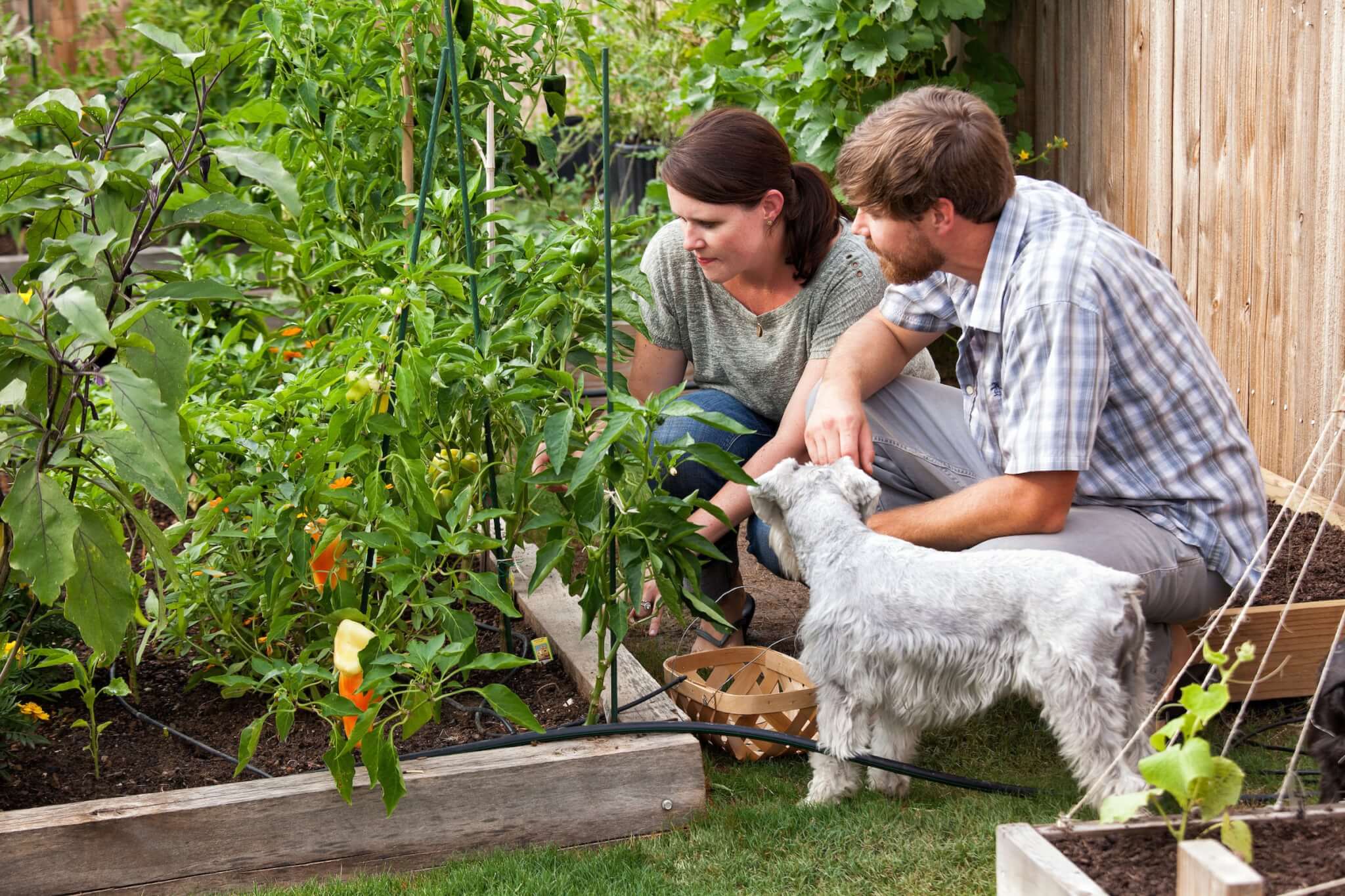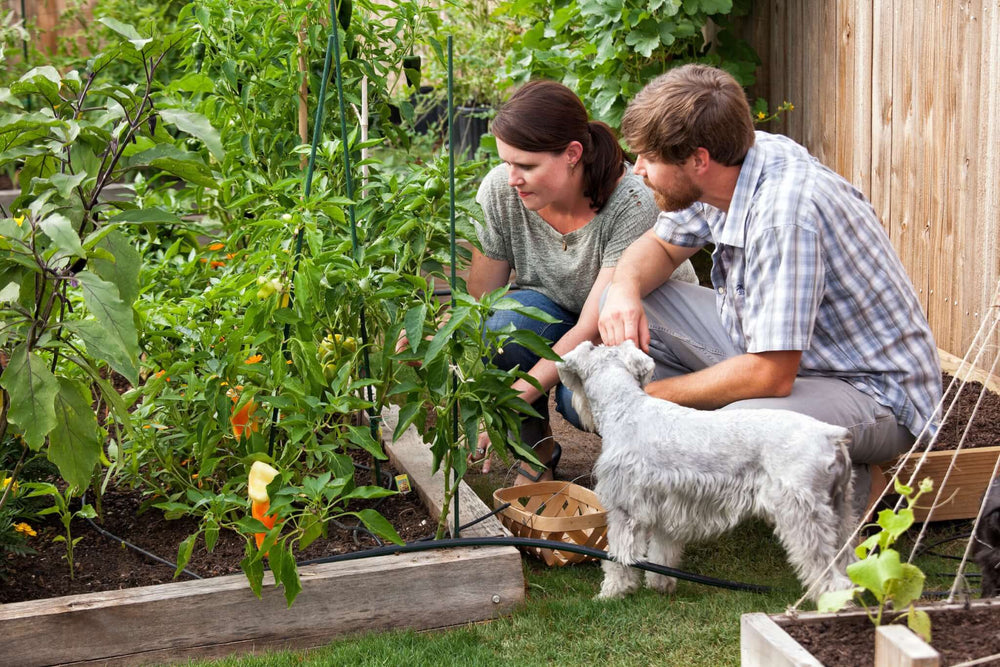
You've picked up your favorite Bonnie Plants® and settled them into the soil of your raised bed, in-ground, or container garden. Time to relax and let those babies grow, right? Well, kind of. Like children who still need guidance, your garden needs TLC, too. Providing regular vegetable garden care throughout the growing season helps maintain a lush, thriving vegetable garden that produces the harvest you were probably dreaming about before you began. To help make the most of your efforts, we've narrowed it down to 7 simple steps so you can garden smarter, not harder.
Let's get started!
1. Water Well
No matter what type of garden you've planted—a raised bed, container, or in-ground—your veggies will need consistent water; too much can upset them just as greatly as too little. So, how much water will keep your plants happy without drowning them? Generally, most gardens need about an inch of water each week. That said, container plants demand a bit more. Because they're nestled into a finite amount of soil in well-draining pots, these veggies are often thirstier than those in the ground or in raised beds. During the high heat of summer or in windy conditions, you may need to water container gardens every day.
Always check the soil first—if the top inch is dry, your plants are probably thirsty. Try to water early in the morning to prevent evaporation, and aim your hose near the base of the plants to get moisture to the roots. If you can avoid splashing water and soil onto the leaves, that will help reduce the chance of disease.
The right amount of H2O also depends on what you're growing. Some herbs, like thyme, prefer well-drained, fairly dry soil, while plants like watermelon and cucumbers need plenty of water to produce their delicious fruit. Check the Bonnie plant tag to learn the specific needs of each plant.
2. Be a Feeder
What's a refreshing drink without a little food to go with it? Once your young plants are off and growing—about a month after planting—begin giving them regular boosts of nutrition. When you follow the label instructions, Miracle-Gro® Shake ‘n Feed® Tomato, Fruit & Vegetable Plant Food nourishes your plants both below and above the soil line for up to 3 months, giving them what they need to grow nice and strong. Well-fed plants can more easily fight off pests and diseases, and they also develop a robust root system that helps them better absorb water. Your extra thirsty container plants will love it, because not only will they retain more moisture, but frequent watering tends to wash essential nutrients out of their containers.
3. Maintain with Mulch
Add a 2 to 3-inch-thick layer of mulch around the base of your veggies to help keep weed seeds from growing—it blocks the sunlight they need to germinate. Mulch serves a few other fantastic purposes, too: It retains moisture in the soil, helps prevent soil from splashing onto plants when watered (which reduces soil-borne diseases), and it even helps regulate soil temperature. A layer of mulch keeps it a bit cooler in the summer but warmer when the temps drop, protecting the plant roots from extreme highs and lows. Just make sure you don't pile it up against the plants' stems, as that will cut off crucial air flow. In addition to its functional purposes, mulch also adds a nice aesthetic to the garden, giving beds and containers a finished, professional look. So pick your favorite—bark, double-ground hardwood, pine straw, or even shredded leaves—and let mulch relieve some of your vegetable garden care duties.
4. Weed Without Mercy
Your plants love a good, nourishing snack and thirst-quenching drink. But guess what? So do weeds. These rude, uninvited garden intruders crowd out your veggies, pilfer their water and nutrients, and even steal their sunlight. While it's one of the most unhappy garden tasks, weeding your garden is necessary. it's also therapeutic. Having a bad day? Go yank out those nasty weeds (including the root, or it will grow right back), and you're guaranteed to feel much better. Plus, if you remove weeds as soon as you see them, they're less likely to set seed and cause future problems. Plan a daily stroll through the garden, so you can spot young weeds—which are much easier to remove—and evict them as soon as they appear.
5. Eliminate Pests or Disease
Sometimes, despite your best efforts, a yellow leaf or droopy plant appears in your vegetable garden. Quick! It's time to investigate what's ailing your plants, because the sooner you spot problems, the faster you can jump into action and rescue them.
Check each stem, leaf, and flower for signs of garden pests. Also look on the undersides of leaves, where many pests like to lay eggs. If you spot small bugs crawling around—like those all-too-common aphids—try removing them with a strong spray of water. For larger pests, like tomato hornworms or Japanese beetles, pick them by hand and drop them into a bucket of sudsy water. If it's a full-on infestation, use insecticidal soap on the entire plant, making sure to spray both sides of the leaves. To better identify which pest might be causing problems in your garden, and ways to deal with it, check out our Bonnie Pest section.
If you notice odd spots or leaf discoloration on your veggie plants, yet no pests are present, you may be dealing with a disease. Remove any affected leaves, including those on the ground, to avoid it spreading to other plants. Drop them in your trash, not the compost, to prevent future problems. If doing that doesn't take care of the issue, contact your local Extension Service for help pinpointing what's going on and what to do about it.
6. Support Your Plants
Some of your plants might like to get a little rambunctious, towering over their neighbors or weaving throughout the beds. Rein in these overzealous growers with a good support system. Indeterminate tomato vines, for instance, can grow up to 6 or 7 feet tall. Rather than letting them sprawl on the soil where they might pick up disease, add cages or stakes when planting and then train them to climb up the support as they grow.
Likewise, pole beans and vining cucumbers take up a lot of garden real estate as they ramble through beds. Growing these veggies vertically doesn't just save garden space, but it also helps keep them healthy by providing air circulation and elevating them from soil-borne disease. Plus, your back will appreciate the upright ease of harvesting these garden goodies!
7. Enjoy the Journey
Take a stroll through your garden every day. There's nothing nicer than watching your green babies grow into hardy, mature plants, and daily visits mean you'll be there to notice any pests or problems. Keep an eye on them as they grow and soon enough, they'll be producing great harvests for your favorite garden-to-table meals.




 Herbs
Herbs
 Vegetables
Vegetables
 Fruit
Fruit
 Flowers
Flowers
 Succulents
Succulents


